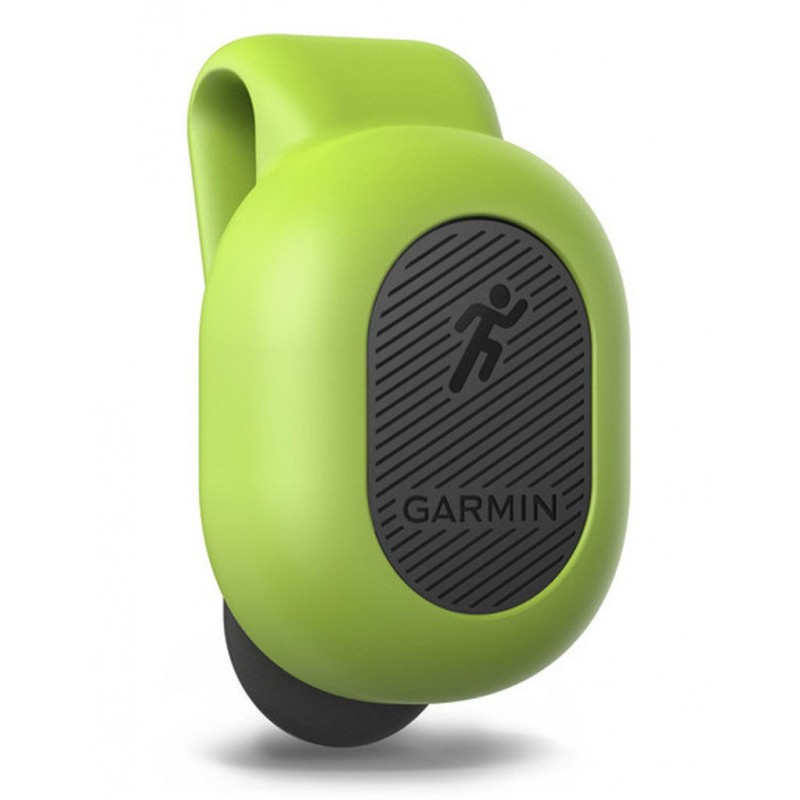



Featherweight detector of running dynamics
010-12520-00
Only 12g lightness
Clip-on, easy to apply on the back elastic of the pants
Measure all six advanced running dynamics1
Replaces metrics detected by the RUN1 cardio band
Battery life up to 1 year
Automatically activates on movement
Connects via Bluetooth® with the compatible Garmin device1
Why the new Runnin Dynamic Pod
Garmin offers more and more products that measure heart rate on the wrist thanks to Garmin Elevate technology™ 2.0, however, until today, to have even the data of running dynamics it was necessary to wear an HRM-Run cardio band®. Thanks to the new Running Dynamic Pod you can decide not to wear the band anymore and have all the data anyway simply by applying the pod on the elastic of the shorts and detect the beat directly on the wrist with a tool equipped with Garmin Elevate detection.
Contact time with the ground
It is the time of contact of the foot with the ground during the run. Generally, the contact time with the soil is decidedly short, so it is measured in milliseconds. The contact time with the ground tends to be particularly short for more trained athletes, whose times are often less than 200ms. In practice, the contact times with the soil of all trained athletes is less than 300ms, probably because they have refined their running technique by lifting their feet more quickly and stepping on the ground properly. "Overstriding" describes a running style in which the feet trample the ground too far from the body by braking movements and, generally, increasing contact times with the ground.
Balancing contact time with the ground
Monitoring the balance of ground contact time (GCT) between left and right foot allows you to measure the symmetry of the stroke. On Garmin smart watches this figure is always represented as a percentage of more than 50% with an arrow to the left or right, to show which foot tramples the ground the longest. For most people a more symmetrical running style is preferable. The colored indicators on Garmin watches and on the Garmin Connect™ portal, show the balance data compared to other athletes. Many athletes report that GCT balance tends to deviate from 50/50 when running uphill or downhill, when practicing speed exercises, or when they are tired. In addition, some athletes note that the higher the imbalance, the higher the probability of injury.
cadence
This is the number of steps taken per minute, counting both feet. It is a common running metric, which provides a lot of information about the quality of the ride. For example, at a certain pace, faster cadence and a shorter step produce small efforts in many parts of the body, such as hips, knees and hips. According to most experts, the lack of relevance of such forces reduces the risk of injury and injury. It is clear that cadence can only increase up to a certain point, however for athletes most prone to injuries, running at a high cadence can help. An often-cited cadence target is 180 steps per minute, although taller athletes tend to have a lower cadence. In addition, it is interesting to note that a higher cadence corresponds to less vertical oscillation and less contact time with the ground.
Pitch length
Another fundamental fact that measures the style of the stroke is the length of the pitch, that is, the distance traveled by each step, left and right. It is shown at the end of the run as a given field within the task and can be viewed as you run. You can then view this data with more details about Garmin Connect™ and discover changes in pitch length in relation to pace, cadence, altitude, and other metrics. The length of the step depends on a number of factors, including body morphology, muscle strength and flexibility.
Vertical oscillation
It is the "bounce" that you produce in every step of the race. Measured at the level of the torso, it indicates, in centimeters, the distance you travel vertically with each step. Many trainers believe that less vertical oscillation indicates a more efficient running style, as less energy is used for vertical movement. Garmin has researched many athletes of all levels. In general, more experienced runners tend to have less vertical oscillation. However, a faster pitch corresponds to greater vertical oscillation. The vertical ratio (described below) takes this figure into account. Another advantage of a reduced vertical oscillation is to apply less stress to the lower part of the body at the time of impact with the soil.
Vertical ratio
This data is reflected in the efficiency of the stroke in relation to the forward thrust produced with each step. The vertical ratio is the "bounce" produced in the step, divided by the length of the pitch and expressed as a percentage. Since the pitch length is the horizontal movement of the stroke, it is the benefit of the action, while vertical oscillation is one of the energy costs of running. A low vertical ratio value indicates a low cost and a great benefit. This means a more efficient ride.
Physical characteristics
•Unit size (LxAxP): pod with clip 37.6 mm x 23.2 mm x 19.2 mm
•Weight: 12.0 g
•Battery life: 1 year (assuming a usage of 1 hour per day)
•Battery type: CR1632 (user replaceable)
•Waterproofing rating: 1 ATM
Additional features
•ANT+® connectivity: yes